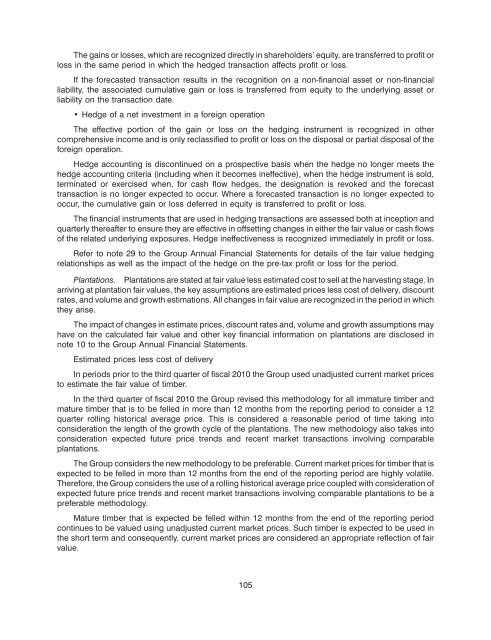Create successful ePaper yourself
Turn your PDF publications into a flip-book with our unique Google optimized e-Paper software.
The gains or losses, which are recognized directly in shareholders’ equity, are transferred to profit or<br />
loss in the same period in which the hedged transaction affects profit or loss.<br />
If the forecasted transaction results in the recognition on a non-financial asset or non-financial<br />
liability, the associated cumulative gain or loss is transferred from equity to the underlying asset or<br />
liability on the transaction date.<br />
Hedge of a net investment in a foreign operation<br />
The effective portion of the gain or loss on the hedging instrument is recognized in other<br />
comprehensive income and is only reclassified to profit or loss on the disposal or partial disposal of the<br />
foreign operation.<br />
Hedge accounting is discontinued on a prospective basis when the hedge no longer meets the<br />
hedge accounting criteria (including when it becomes ineffective), when the hedge instrument is sold,<br />
terminated or exercised when, for cash flow hedges, the designation is revoked and the forecast<br />
transaction is no longer expected to occur. Where a forecasted transaction is no longer expected to<br />
occur, the cumulative gain or loss deferred in equity is transferred to profit or loss.<br />
The financial instruments that are used in hedging transactions are assessed both at inception and<br />
quarterly thereafter to ensure they are effective in offsetting changes in either the fair value or cash flows<br />
of the related underlying exposures. Hedge ineffectiveness is recognized immediately in profit or loss.<br />
Refer to note 29 to the Group Annual Financial Statements for details of the fair value hedging<br />
relationships as well as the impact of the hedge on the pre-tax profit or loss for the period.<br />
Plantations. Plantations are stated at fair value less estimated cost to sell at the harvesting stage. In<br />
arriving at plantation fair values, the key assumptions are estimated prices less cost of delivery, discount<br />
rates, and volume and growth estimations. All changes in fair value are recognized in the period in which<br />
they arise.<br />
The impact of changes in estimate prices, discount rates and, volume and growth assumptions may<br />
have on the calculated fair value and other key financial information on plantations are disclosed in<br />
note 10 to the Group Annual Financial Statements.<br />
Estimated prices less cost of delivery<br />
In periods prior to the third quarter of fiscal 2010 the Group used unadjusted current market prices<br />
to estimate the fair value of timber.<br />
In the third quarter of fiscal 2010 the Group revised this methodology for all immature timber and<br />
mature timber that is to be felled in more than 12 months from the reporting period to consider a 12<br />
quarter rolling historical average price. This is considered a reasonable period of time taking into<br />
consideration the length of the growth cycle of the plantations. The new methodology also takes into<br />
consideration expected future price trends and recent market transactions involving comparable<br />
plantations.<br />
The Group considers the new methodology to be preferable. Current market prices for timber that is<br />
expected to be felled in more than 12 months from the end of the reporting period are highly volatile.<br />
Therefore, the Group considers the use of a rolling historical average price coupled with consideration of<br />
expected future price trends and recent market transactions involving comparable plantations to be a<br />
preferable methodology.<br />
Mature timber that is expected be felled within 12 months from the end of the reporting period<br />
continues to be valued using unadjusted current market prices. Such timber is expected to be used in<br />
the short term and consequently, current market prices are considered an appropriate reflection of fair<br />
value.<br />
105
















